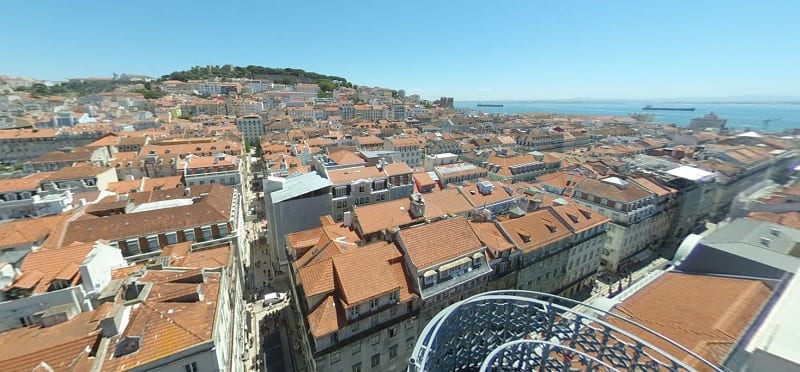This post provides several free things to do in Lisbon, including a few really cheap activities.
We have organized this post into 5 sections, one for each of the most popular neighborhoods for visitors to Lisbon and an additional section to cover some of the other fun things to do in this city.
Before we get into the activities and attractions you can enjoy in each neighborhood, let’s go over some of the best ways to save money and see the sights in Lisbon
Take a Free Walking Tour
Lisbon can be difficult to navigate if you aren’t familiar with the area, so you may want to consider taking a tour to become more acclimated with the city and learn about its history.
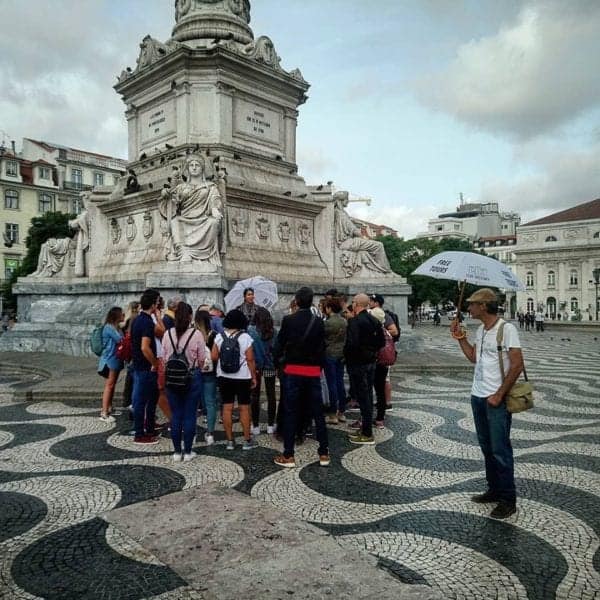
We offer free, self-guided tours for each of the neighborhoods listed below and we link to these tours in each respective section.
There are however several free tours you can take which will provide a general overview of Lisbon. These services really are pay-what-you-wish, which means you can decide how much it was worth at the end of the tour (even free).
For more information, please read our post covering free Lisbon walking tours.
Ride the Trams and Funiculars
There are some pretty steep hills in Lisbon, so you’ll probably want to make use of the public trams and funiculars in the city to get around.
Here are a few of the most notable trams and funiculars:
- Ascensor da Glória
- Ascensor do Lavra
- Ascensor da Bica
- Tram 28E
Tram 28E is noted for being one of the best trams for tourists, as it provides a variety of notable stops throughout several neighbourhoods in Lisbon, including many excellent examples from our lists in this post.
More likely than not you will be purchasing a transport pass and essentially making these rides free, otherwise they only cost between €3 - €4 per ride.
Save Money With the Lisboa Card
Many of the attractions listed in this post are actually included at no additional cost with the Lisboa Card, a tourist attraction discount pass you can use to save money on general admission costs.
This service also provides a free transport card for the length of time that the tourist pass is valid (1, 2, or 3 days), and it covers every form of public transportation in the city.
Here are just a few of the locations you can visit with the Lisboa Card:
- Belém Tower | €6
- National Pantheon | €4
- LISBOA Story Centre | €7
- National Tile Museum | €5
- Jerónimos Monastery | €10
- Pilar7 Bridge Experience | €6
- National Coach Museum | €8
- National Costume Museum | €4
- National Museum of Theatre and Dance | €4
- And more!
For as little as €14 per day, it’s easy to see how you could start to save quite a bit of money with the Lisboa Card.
As long as you use it for at least 3-4 activities per day, you should be able to get a great discount.
For more details, please read our post covering Lisbon tourist passes.
FREE THINGS TO TO IN BAIXA
This district of Lisbon is also known as “low town,” as it is located at the bottom of all the hills. This is the city’s tourism core and it's where many first time visitors choose to stay.
We have created a list of the top sights to see in the Baixa, which also acts as a free self-guided tour.
Go to Praça do Comércio
Also known as Commerce Square, this plaza is located right alongside the Tagus river, which makes it one of the most popular meeting spots in all of Lisbon.
There are a variety of things to see here, including the most visible landmark at the center of the square, a statue of King Jose I on horseback.
Praça do Comércio was once the former site of a royal palace, but it was unfortunately destroyed during an earthquake in 1755.
While most of the nearby buildings have since become used for a variety of businesses, they still maintain some of the nicest architecture in the entire city.
Visit the Money Museum
This relatively new museum showcases the concept of money and how it has been used throughout human history, as well as revealing its role in Portugal’s historical development.
In addition to learning about how money came to exist in the world, you can also virtually mint a coin, print a banknote with your face, and use a microscope to see what money looks like close up.
Contrary to its name, this museum is actually entirely free to visit and is open from 10:00 am - 18:00 (6 pm).
The Money Museum is housed in the former church of S. Julião, which is just a few blocks away from both Praça do Comércio and Arco da Rua Augusta.
See King Dinis’ Wall
Located in the crypt of the former church of S. Julião, this is one attraction you definitely won’t want to miss while you’re at the Money Museum.
King Dinis’ Wall has been designated a national monument, and it’s the last known remnant of Lisbon’s medieval wall.
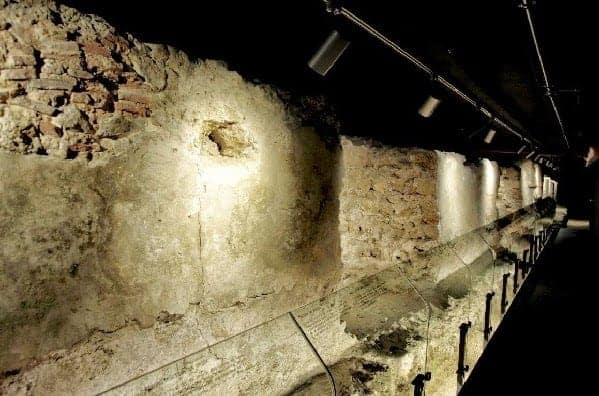
In total there are several objects, images, and sounds covering over 1,000 years of Portugal’s history.
After the earthquake of 1755, it was thought that much of this wall and many other items from the royal palace were lost, but during an excavation in 2010 they managed to find what you’ll see here.
In addition to the artifacts, there are also a variety of multimedia presentations including medieval music, 3D animations, films and more. Needless to say, admission is free!
Hop on the Elevador de Santa Justa
There are some pretty steep hills in Lisbon, and one of them is so difficult to climb that they actually crafted an elevator to help people reach the top.
The Elevador de Santa Justa climbs 46 m (150 feet) from Baixa to Bairro Alto (which translate to ‘low’ and ‘high’ towns) and it was built in 1902.
Despite its age, it remains in use to this day and is quite safe.
The view from the platform is free, but if you will have to pay to reach the top viewing platform (€1.50) or ride the elevator (€5.40 round trip).
You can hop on the free modern elevators nearby instead, or if you use the Lisboa Card or a transport pass, you’ll be given free access to the Elevador de Santa Justa!
Go to the Museum of Design and Fashion
Also known as the MUDE Museum, this attraction is focused on the artwork of fashion and industrial design.
According to some, they have the best collection of 20th-century fashion in all of Europe!
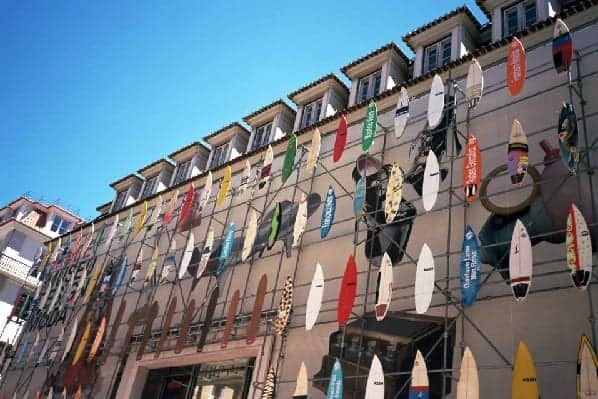
Over 2,000 items are housed in this collection, including a variety of clothing, jewelry, furnishings, and even historic typewriters.
They also have some displays which change on a regular basis, giving you a reason to come back for a second or even third visit!
The Museum of Design is entirely free to visit, and they are open from Tuesday through Sunday every week.
Visit the Núcleo Arqueológico da Rua dos Correeiros
Lisbon is a city filled with history, but few locations will take you back further than this underground excavation which uncovered archeological remains dating back over 2,000 years!
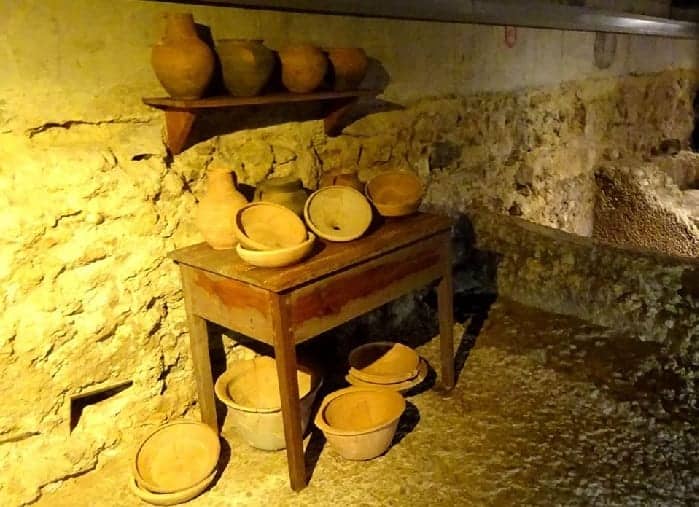
During the 1990s, an excavation was performed under Portugal’s Millennium BCP bank, and during the process, they found items from pre-Roman times.
These artifacts remain carefully preserved and displayed thanks to the bank, and you can actually take a tour of the dig and see what they found for yourself.
Tours are free and available Monday through Saturday with the exception of public holidays. It is recommended to book your tour at least a day or two in advance to avoid missing out.
Learn more at the official website.
Go to the Church of St. Dominic
This is one of the oldest standing churches in Lisbon, dating back to the year 1241, and noted for having survived the earthquake of 1755 that demolished the royal palace.
While a fire in 1959 destroyed and charred the interior of the church, the building itself remains intact after all these years, as does much of the original Baroque architecture.
In addition to the church itself, St. Dominic’s Square is yet another popular draw in the area where Lisbon’s African community gathers on a daily basis.
Other Things to Do in Baixa
In addition to the examples we have covered above, you may also want to consider some of these activities or attractions as well:
- World’s Oldest Book Store (Bertrand)
- Take a Self-Guided Tour
- Calçada Portuguesa (pavements)
- Ascensor da Glória Funicular
- Ascensor do Lavra Funicular
- Arco da Rua Augusta
- Praça da Figueira
- Terreiro do Paço
- Rossio Square
FREE THINGS TO DO IN BAIRRO ALTO/CHIADO
Sometimes you have to ascend a few hills if you want to get the best views.
And there are plenty of great places to see the rest of the city in Bairro Alto, as well as some of the most notable historic landmarks in all of Lisbon.
This section includes a variety of fun things to see and do for free in the Barrio Alto neighbourhood, otherwise known as “high town.”
Be sure to access our neighbourhood guide, which also serves as a free, self-guided tour.
Ride the Funiculars to Reach Bairro Alto
If you’re looking for an easy way to climb the steep hills of Lisbon to the Barrio Alto neighbourhood, there are two funiculars that should help: Elevador da Gloria and Elevador da Bica.
While these aren’t necessarily free to ride, they are usually very cheap (€1 - €3 per ticket).
The Gloria funicular will take you from Restauradores Square in Baixa to Rua San Pedro de Alcántara in Bairro Alto.
The Bica funicular runs up Rua da Bica de Duarte Belo, also helping people ascend the hills and reach Calçada do Combro from Rua de São Paulo.
Alternatively, you can also take Tram 28 to reach Bairro Alto, and this tram will also connect you with many other neighborhoods in the city including Afalma, Chiado, Baixa and more.
Enjoy the View From Miradouro de São Pedro de Alcântara
There are a lot of great places to get a nice look at the city of Lisbon, but few locations offer as beautiful of a view as Miradouro de São Pedro de Alcântara.

Located at Jardim António Nobre (map), this viewing deck offers panoramic views of the city that rival those you’ll see at the Castle of São Jorge, and it’s entirely free to visit this attraction.
From here you’ll be able to see sites such as the castle hill and walls, Baixa, Alfama, the Se Cathedral, the Tagus river, Martim Moniz, Mouraria and many other sites.
There are also telescopes available for anyone who wants to get an even better look at Lisbon and its many beautiful landmarks.
Visit Igreja de São Roque
Built in the late 16th century, this church is an excellent example of the baroque architectural style, and there are many beautiful chapels inside including the Chapel of St. John the Baptist.
This is yet another notable structure that managed to survive the earthquake of 1755, and it actually made it through the disaster somewhat unscathed.
Whether or not you’re religious, this is definitely one of the best landmarks to see in the Bairro Alto neighbourhood, especially if you’re interested in art or architectural history.
See the Carmo Convent Ruins
There are a lot of notable sites that survived the earthquake of 1755, but this convent is one location that wasn’t so lucky.
Thankfully, much of the building still exists, but it no longer serves the same functions as before.
At the time the earthquake hit, this was actually the largest church in Lisbon, but sadly the roof collapsed after the disaster and all that remains are the arches and rubble.
Despite the fact that the building was ruined, it has since been turned into an open-air museum which includes several statues, ceramics, mosaics and even the tomb of King Ferdinand I.
This museum isn’t free to visit, but tickets are affordable – and they are included for free with the Lisboa Card.
Visit the official website for more information.
See the View at the Elevador de Santa Justa
We mentioned this landmark earlier, but we really need to stress the great views from the top. Click on the image below to see a 360-degree panoramic.
You can access for a small fee of €1.50. If you are riding the elevator down, there is another view almost as good included in the price.
TIP: In the high season, there could be an hour-long wait for the viewing platform. You can skip the line by walking to the platform from the Carmo Convent Ruins.
Enjoy the Nightlife for Free
Bairro Alto has plenty of great restaurants and bars which often host musicians on most nights, and some of them don’t even have a cover charge!
Some of these locations specialize in Fado shows, and while they may charge for entrance, you can usually hear them from outside when walking by.
Simply walking through the streets of Bairro Alto after the sun goes down can be a fun experience, as you’ll often hear a variety of music and see plenty of interesting people.
That said, if you’re particularly interested in experiencing the unique tunes of Portugal, consider heading into Tasca do Chico for live Fado music that won’t cost a thing to enjoy!
Other Things to Do in Bairro Alta/Chiado
In addition to all of the activities listed above, here are a few more ideas you might want to consider while spending time in the Bairro Alta/Chiado neighbourhoods of Lisbon.
- Pharmacy Museum (cheap)
- Views from the Park Bar (cheap)
- Take a Free Walking Tour
- Museum of Contemporary Art (cheap)
- Visit Loja das Conservas
- Museum of Sacred Art
- Visit Embaixada
FREE THINGS TO DO IN ALFAMA
Located on the eastern side of Lisbon, this district is home to some of the most historic landmarks in the whole city, as well as some interesting museums and excellent views of the rest of the city.
The Alfama is what many think of when they think of Lisbon, small, tight, winding cobblestone roads, laundry lines, and beautiful tile work.
Use our neighborhood guide to get a sense of the area and where to go. It is a free, self-guided tour.
See the Miradouros of Alfama
There are a lot of great places to enjoy an excellent view of Lisbon, but three of the best Miradouros are actually in the Alfama neighbourhood.
One of the best scenic spots is Miradouro das Portas do Sol, which provides an incredible view of the city, including a great look at the São Vicente de Fora Monastery and the waterfront.
Miradouro de Santa Luzia
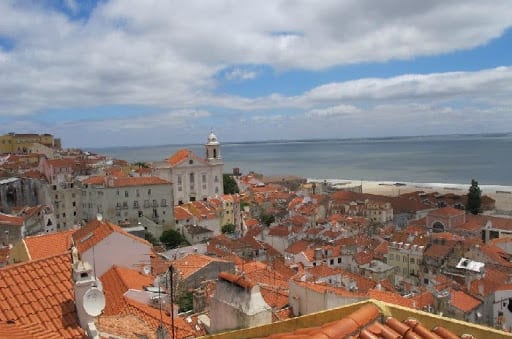
Another excellent option is the Miradouro de Santa Luzia, which is actually just a few steps away. Visitors can enjoy views of various beautiful architecture in Lisbon, as well as the Tagus river.
Finally, consider checking out the Miradouro de Graça, located above São Vicente de Fora Monastery and accessible by Tram 28. This viewing deck offers great views of the castle and Alfama.
Each of these locations is entirely free to visit!
Discover the Se Cathedral
This is arguably one of the most iconic religious buildings in all of Lisbon, as it has been the site of many baptisms, marriages and other events in the lives of Portugal’s nobility since the 12th-century.
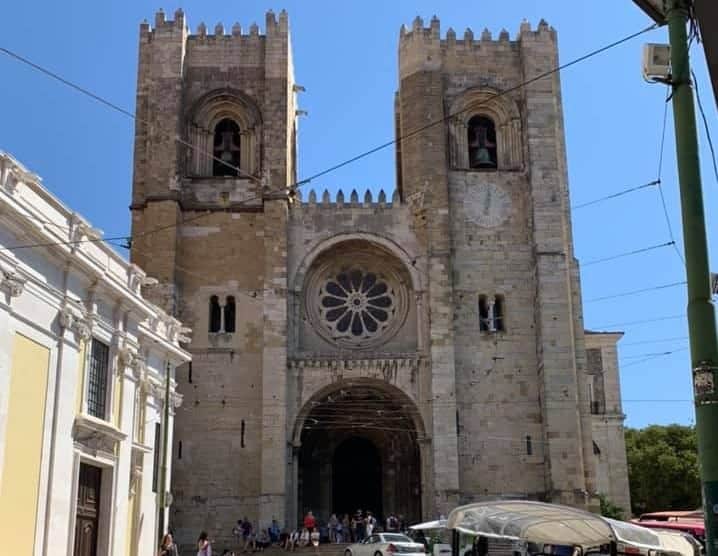
Many note upon the first inspection that the Se Cathedral actually looks more like a castle from outside as if designed to withstand battle.
The structure has not one, but two large clock towers and the interior is filled with a variety of decorative altars, medieval statues, cloisters, and alcoves.
While it’s free to visit the main cathedral, some areas will require a ticket – but admission prices are fairly reasonable.
Go to the Museum of Resistance and Liberation (Cadeia do Aljube)
Dig deep into the history of Portugal at this museum and former prison to learn about how the country fought against dictatorship and eventually liberated itself.

The Museum of Resistance and Liberation, located near the Se Cathedral, houses both a permanent exhibition and temporary exhibits which frequently change every few months.
Although most adults will require a ticket, admission is quite affordable and there are discounts for both young adults (13-25) and senior citizens (65+). 12 and younger are free.
Visit the Thieves Market
Although this location has colloquially been given a rather dubious title, Feira da Ladra is actually just a flea market where you can find a lot of random knick-knacks on sale.
If you’re looking for a unique trinket or souvenir to bring home from Lisbon, this is a great marketplace to visit.
The flea market is held every Tuesday and Saturday from dawn till the afternoon.
Even if you don’t feel like spending any money, chances are you’ll find quite a few interesting things for sale here and it’s a great place to experience some of the lesser-seen cultural traditions in Portugal.
The so-called “Thieves Market” takes place at Campo de Santa Clara (map) and you can reach this site via Tram 28.
Get Lost in the Labyrinthian Streets
The streets of Alfama can be a bit difficult to navigate, but sometimes it’s fun to just walk around and see what you can find.
You never know what random restaurant or store you’ll find while wandering around these often narrow and interesting roads.

In addition to the various businesses, you may also stumble upon a variety of different architectural styles including classic Portuguese tiling, cobblestone stairways and more.
However, here is a step by step guide from the Portos do Sol viewpoint downhill toward the Baixa.
Travel Through Alfama on Tram 28E or Tram 12E
If you’re looking for a convenient way to get around Alfama and see the sites, Tram 28E and Tram 12E are excellent and affordable options you should definitely consider.
These trams stop at 2 of the most popular landmarks in the area: the Se Cathedral and Portas do Sol.
Admission is affordable and it’s actually included with at least one Lisbon tourist pass!
Other Things to Do in Alfama
If you’re looking for even more to do in this neighbourhood, there are still several great ideas for activities and attractions you can enjoy while in Alfama, including the following:
- Take a self-guided tour
- See the Statue at the Church of St. Anthony
- Go to the Roman Theatre Museum (cheap and free for kids)
- See the National Tile Museum (free for kids 12 and under)
- Go to the Fado Museum (free for kids 12 and under)
- See the Sao Vicente de Fora Monastery
- Visit the National Pantheon
- And more!
FREE THINGS TO DO IN BELÉM
Originally the site of Lisbon’s docks and shipyards, this district is now the home of several notable and historic landmarks, as well as some great museums, parks, plazas, and excellent views.
Be sure to read our guide on things to do in Belém, which doubles as a free, self-guided tour.
Visit the Belem Tower
This is easily the most popular and notable site in the Belém district, and it’s not hard to see why, as this tower once guarded Lisbon’s harbor.

Belém Tower was also the location where many voyages of discovery embarked, a symbol of Portugal’s age of discovery. Built in 1515, the structure has been listed as a World Heritage monument.
In addition to the fantastic architecture, there are also several great sculptures on display ranging from historical figures to rare and exotic animals.
Admission is pretty affordable, but if you want to save some money, it’s worth noting that tickets are included with at least one Lisbon tourist pass.
Go to the Jerónimos Monastery
Located at the Praça do Império, this landmark is one of the most beautifully designed structures in all of Lisbon, with several interesting sculptural details.
The Jerónimos Monastery was originally built to commemorate the voyage of Vasco Da Gama, whose tomb was placed inside near the entrance.
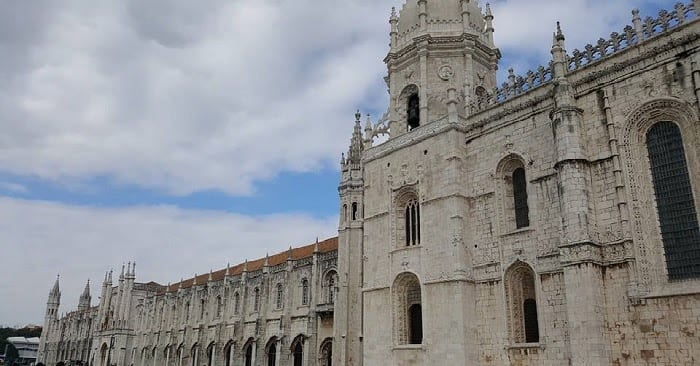
There are several other notable figures from throughout the history of Portugal buried at this monastery, including King Manuel, King Sebastião and many others.
Although it’s free to enter the chapel, the monastery itself will require a ticket. Thankfully, you can save money on admission by using a Lisbon tourist pass.
See the Padrão dos Descobrimentos
Otherwise known as the Monument of the Discoveries, this large sculpture is almost impossible to miss.
Located on the northern bank of the Tagus river, this attraction celebrates the age of discovery in Portugal.
During the age in question, Portuguese sailors would travel the world visiting locations like India and the Orient to explore and trade with other countries.
This monument is also at the Praça do Império, and it is roughly 52 metres (170 ft.) high.
It depicts historic figures such as Henry the Navigator, as well as several monarchs, explorers, cartographers, and other notable people from the 15th and 16th centuries.
Tickets to reach its viewpoint are very affordable and admission is actually free for all children under the age of 12. You can also save money on tickets by using a Lisbon tourist pass.
Visit the Garden of Alfonso de Albuquerque
Located near the Belem Palace and the National Coach Museum, this garden/public square is one place you’ll definitely want to see while exploring the neighborhood.

One of the first things you’ll notice here is the Albuquerque monument, which was erected in honor of Alfonso de Albuquerque, governor of Portuguese from 1507 - 1515.
In addition to seeing the monument and taking in the nearby sites, this location is also notable because several free tours start from the Garden of Alfonso de Albuquerque.
Best of all, since it’s open to the public, there’s no fee to visit the garden!
Go to the Tropical Botanical Garden
If you’re looking for more flowers and greenery, there are plenty of beautiful growing things to see in this garden.
In addition to towering palm trees all over the place, there are over 4,000 additional species of tropical plants.
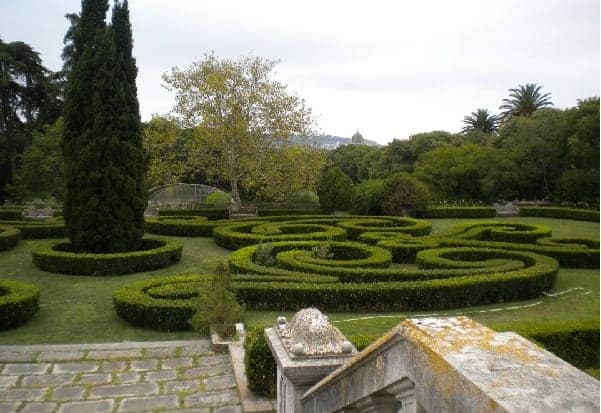
Many of these plants are actually endangered species, and most of them are labeled to help you identify all the different types of greenery in the garden.
This is one site you probably wouldn’t expect to see in Portugal, but thanks to donations made over the years from all over the world, they’ve been able to amass an impressive collection of rare tropical scenery.
Admission is very affordable at a price of just €3 for adults and €1.50 for children, so although it isn’t free, this attraction also won’t cost too much to visit.
Take a Walk Along the Riverside
Belem is located right along the Targus river, so there’s a pretty good chance you’ll see the water while wandering around this district.
That said, you might actually want to consider just going for a riverside walk, taking in the sites and experiencing the best this neighborhood has to offer.
While walking alongside the river, you should be able to easily spot landmarks such as the Belem Tower, the Jerónimos Monastery, Arco da Rua Augusta and more.
Best of all, simply taking a walk around this area is entirely free and won’t cost you anything to enjoy.
Other Things to Do in Belem
In addition to everything else we have listed in this section, there are several other activities and attractions to consider in the Belem neighbourhood of Lisbon.
- Visit National Palace of Ajuda (free to view from outside)
- Go to the Museum of Art, Architecture and Technology (cheap)
- See a Show at the Portuguese School of Equestrian Art (cheap)
- Visit the National Coach Museum (cheap)
- Go to the Maritime Museum (cheap)
- Take a Self-Guided Walking Tour
- Enjoy the Sunset by the River
- And more!
OTHER FREE THINGS TO DO IN LISBON
In addition to all the great activities you can enjoy in each of the neighbourhoods we’ve covered above, there are several other places you might want to visit in Lisbon.
This section will cover some of the attractions and things to do that we may have missed in other areas of the post.
Go to a Public Park
There are a lot of great public parks to see in Lisbon, and they’re all free to visit. That said, we recommend two excellent locations in particular: Jardim da Estrela and Jardim do Príncipe Real.
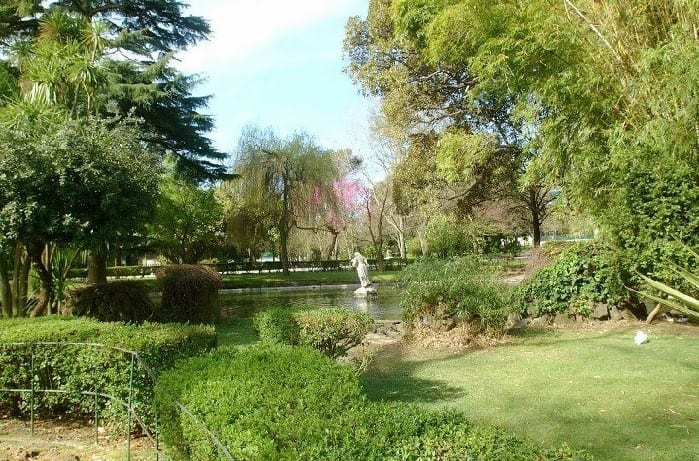
Jardim da Estrela is located at the west end of the city, and there are a lot of fun things to see and do here, including sculptures, a playground for kids, and even a small lake where you might see a few ducks.
This park is at the end of the line for Tram 28E, so if you’re planning to use that service, you simply need to ride the tram almost to its final destination.
Here is a resource about the park.
Alternatively, you might also want to check out Jardim do Príncipe Real, a small public square and garden on the main street of the Príncipe Real Real neighbourhood.
This park is notable for the giant cedar tree which provides a lot of shade during the warmer months. There is also a small cafe with outdoor seating and they often host a local farmer’s market at Jardim do Príncipe Real on Saturdays.
Visit a Cemetery
Although it might not be the first place you’d think to visit, the cemeteries of Lisbon are great places to learn about the history of the city and see some of the interesting funerary architecture.
There are two excellent cemeteries you may want to consider checking out while you’re in Lisbon: Cemitério dos Prazeres and Cemitério do Alto de Sao Joao.
Cemitério dos Prazeres can be found near Jardim da Estrela and is also accessible via Tram 28.
This cemetery is the final resting place for several notable Portuguese civilians including Prime Minister Maria De Lurdes Pintasilgo and writer Jose Cardoso Pires.
Cemitério do Alto de Sao Joao is just East of Alfama, and in addition to being the site of Portugal’s first crematorium, there are a lot of creative and interesting gravestones to be seen, many including beautiful statuaries.
Discover the Subculture of Street Art in Lisbon
Although you won’t find it on every street corner, Lisbon is actually home to a rather vibrant street art scene and there are a lot of beautiful pieces to see throughout the city.
One of the best locations to see this artwork is Mouraria, where you’ll find entire walls dedicated to the Fado music scene with a variety of unique styles from several different artists.
There are also some great examples to see in Bairro Alto, Alfama, Alcântara and many other neighbourhoods in Lisbon.
If you want some help finding the best artwork, consider taking a self-guided Lisbon street art tour or Take Lisboa's Alternative Free Tour.
Visit the Lx Factory
What was once one of the biggest factories in the city has since been transformed into a place where everyone in the community can come together and celebrate art, architecture, music, and many other subjects.
Among other things, visitors can expect to find a variety of interesting restaurants, stores, art galleries and studios, and even an origami factory!
Additionally, there are events hosted at the Lx Factory on a fairly frequent basis, so you may have an opportunity to enjoy some live music or even artistic displays for free.
The Lx Factory is located in Alcântara on the Western side of the city.
You can reach this attraction via trams 15E or 18E. Don’t forget that you can get free access to all public transit with a Lisbon tourist pass.
Enjoy the Sunset
Since Lisbon is located right next to the Targus river, there are usually a lot of beautiful sunsets to enjoy in the region. Even better than that, there are several great viewing decks where you can get a great view of this event each day.
We’ve mentioned more than a few of these sites in our post above, including the following great examples:
- Miradouro da Graça
- Miradouro das Portas do Sol
- Miradouro de Santa Luzia
- Miradouro de São Pedro de Alcântara
- Elevador de Santa Justa
This is a great activity to enjoy right before starting your night, and there are several excellent places throughout the city where you can get a good view of Lisbon.
In other words, no matter where you plan to go after dark, chances are there’ll be a nice viewing location nearby where you can catch the sunset!





